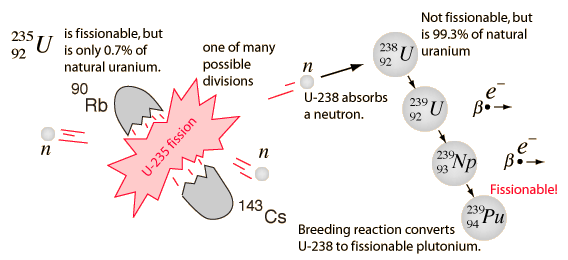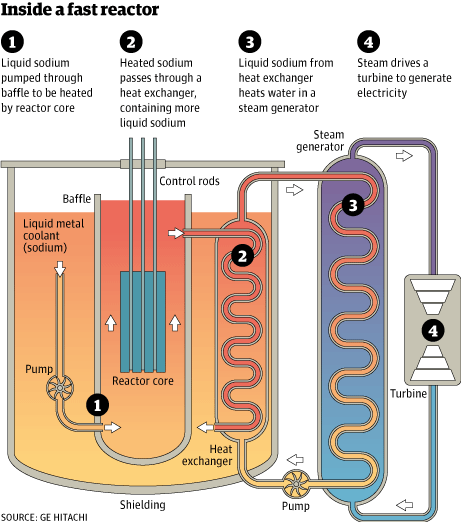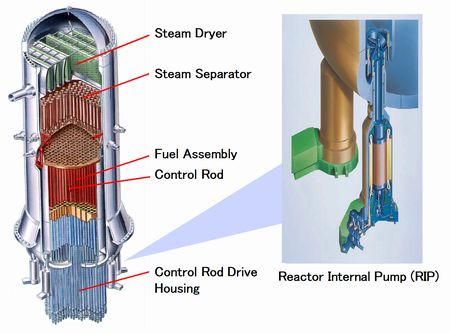Classification of Reactors according to Neutron Flux Spectrum
From the physics point of view, the main differences among reactor types arise from differences in their neutron energy spectra. In fact, the basic classification of nuclear reactors is based upon the average energy of the neutrons which cause the bulk of the fissions in the reactor core.
From this point of view nuclear reactors are divided into two categories:
- Thermal Reactors. Almost all of the current reactors which have been built to date use thermal neutrons to sustain the chain reaction. These reactors contain neutron moderator that slows neutrons from fission until their kinetic energy is more or less in thermal equilibrium with the atoms (E < 1 eV) in the system.
- Fast Neutron Reactors. Fast reactors contains no neutron moderator and use less-moderating primary coolants, because they use fast neutrons (E > 1 keV), to cause fission in their fuel.
The main differences between these two types are, of course, in neutron cross-sections, that exhibit significant energy dependency. It can be characterized by capture-to-fission ratio, which is lower in fast reactors. There is also a difference in the number of neutrons produced per one fission, which is higher in fast reactors than in thermal reactors. These very important differences are caused primarily by differences in neutron fluxes. Therefore it is very important to know detailed neutron energy distribution in a reactor core.


Source: wikipedia.org
Fast Neutron Reactors
On the other hand such reactors must compensate for the missing reactivity from neutron moderator efect. They use fuel with higher enrichment when compared to that required for a thermal reactor. Fast reactors require enrichments about 10%, or more. Most fast reactors use a hexagonal lattice cells (as VVER reactors) in order to reach smaller volume ratios of coolant to fuel. Generally, fast reactors have to utilize much more compact nuclear cores than thermal reactors (PWRs or BWRs) in order to reach required core reactivity. This implies the fast reactor cores achieve higher power densities. As a consequence, they cannot use water as coolant, because of its moderating properties and insufficient thermal properties. The solution given this problem is to use another coolant as liquid sodium or lead.

Source: wikipedia.org
Fast reactor fuel may be metal or a ceramic, encapsulated in metal cladding, unlike the PWR’s zirconium cladding. Liquid metals are the most widely used coolant because they have excellent heat transfer properties and can be employed in lowpressure systems. Sodium-cooled fast reactors (SFRs) are the most common designs. Because sodium reacts violently with water, however, SFRs require the placement of an intermediate heat exchanger between the reactor core and the steam generator. This hi-tech technology requires a lot of experience, therefore only few countries have developed their own fast reactor design (e.g., Russia, USA, France, Japan, ). Especially Russians continue in fast reactor developement program with their BN reactors.
Breeder reactor

Source: hyperphysics.phy-astr.gsu.edu
A breeder reactor is essentially a particular configuration of a fast reactor (but not only FBR can be used as a breeder). Fast reactors generally have an excess of neutrons (due to low parasitic absorbtion), the neutrons given off by fission reactions can “breed” more fuel from otherwise non-fissionable isotopes or can be used for another purposes (e.g.,transmutation of spent nuclear fuel). The most common breeding reaction is an absorbtion reaction on uranium-238, where a plutonium-239 from non-fissionable uranium-238 is produced. A key parameter of breeder reactors is a breeding ratio, although this ratio describes also thermal reactors fuel cycle.
The term “breeder” refers to the types of configurations which can be the breeding ratio higher than 1. That means such reactors produce more fissionable fuel than they consume (i.e., more fissionable Pu-239 is produced from non-fissionable uranium-238, than consumed initial U-235+Pu-239 fuel).
See also: Breeder Reactor
Advantages and Disadvantages
Advantages
- FBRs have improved neutron economy
- FBRs can recycle nuclear waste
- FBRs can produce fuel for thermal reactors
- FBRs liquid metals have superior heat transfer properties
- FBRs do not use pressure vessel
Disadvantages
- FBRs must use superior control system
- FBRs can have positive reactivity feedback from void coefficient
- Liquid metals require special technology and handling
- Fast reactor technology can be more expensive
Generation IV reactors
In 2003 the Generation IV International Forum (GIF) representing ten countries announced the selection of six reactor technologies which they believe represent the future shape of nuclear energy. These were selected on the basis of being clean, safe and cost-effective means of meeting increased energy. Three of the six reactors are fast reactors and one can be built as a fast reactor, one is described as epithermal. Only two operate with slow neutrons like today’s plants.

Source: wikipedia.org
















